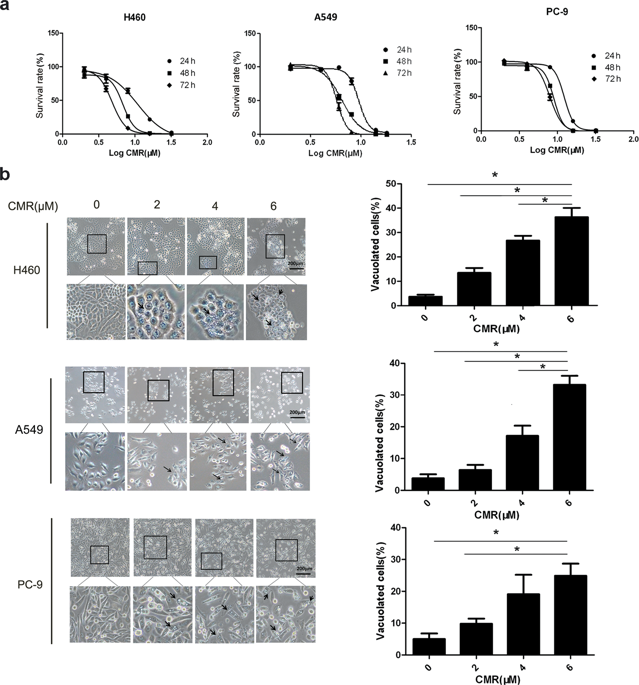当前位置:
X-MOL 学术
›
Acta Pharmacol. Sin.
›
论文详情
Our official English website, www.x-mol.net, welcomes your
feedback! (Note: you will need to create a separate account there.)
Chalcomoracin inhibits cell proliferation and increases sensitivity to radiotherapy in human non-small cell lung cancer cells via inducing endoplasmic reticulum stress-mediated paraptosis.
Acta Pharmacologica Sinica ( IF 6.9 ) Pub Date : 2020-02-17 , DOI: 10.1038/s41401-019-0351-4 Shi-Rong Zhang 1, 2 , Xiao-Chen Zhang 3 , Jia-Feng Liang 1 , Hong-Ming Fang 4 , Hai-Xiu Huang 1 , Yan-Yan Zhao 1 , Xue-Qin Chen 2 , Sheng-Lin Ma 1, 2
Acta Pharmacologica Sinica ( IF 6.9 ) Pub Date : 2020-02-17 , DOI: 10.1038/s41401-019-0351-4 Shi-Rong Zhang 1, 2 , Xiao-Chen Zhang 3 , Jia-Feng Liang 1 , Hong-Ming Fang 4 , Hai-Xiu Huang 1 , Yan-Yan Zhao 1 , Xue-Qin Chen 2 , Sheng-Lin Ma 1, 2
Affiliation

|
Chalcomoracin (CMR) is a kind of Diels-Alder adduct extracted from the mulberry leaves. Recent studies showed that CMR has a broad spectrum of anticancer activities and induces paraptosis in breast cancer and prostate cancer cells. In this study, we investigated the effects of CMR against human non-small cell lung cancer cells and the underlying mechanisms. We found that CMR dose-dependently inhibited the proliferation of human lung cancer H460, A549 and PC-9 cells. Furthermore, exposure to low and median doses of CMR induced paraptosis but not apoptosis, which was presented as the formation of extensive cytoplasmic vacuolation with increased expression of endoplasmic reticulum stress markers, Bip and Chop, as well as activation of MAPK pathway in the lung cancer cells. Knockdown of Bip with siRNA not only reduced the cell-killing effect of CMR, but also decreased the percentage of cytoplasmic vacuoles in H460 cells. Moreover, CMR also increased the sensitivity of lung cancer cells to radiotherapy through enhanced endoplasmic reticulum stress. In lung cancer H460 cell xenograft nude mice, combined treatment of CMR and radiation caused greatly enhanced tumor growth inhibition with upregulation of endoplasmic reticulum stress proteins and activation of pErk in xenograft tumor tissue. These data demonstrate that the anticancer activity and radiosensitization effect of CMR result from inducing paraptosis, suggesting that CMR could be considered as a potential anticancer agent and radiation sensitizer in the future cancer therapeutics.
中文翻译:

酞菁霉素可通过诱导内质网应激介导的截瘫而抑制细胞增殖并增加对人类非小细胞肺癌细胞放疗的敏感性。
酞菁霉素(CMR)是从桑叶中提取的一种狄尔斯-阿尔德加合物。最近的研究表明,CMR具有广泛的抗癌活性,并能在乳腺癌和前列腺癌细胞中诱发截瘫。在这项研究中,我们研究了CMR对人非小细胞肺癌细胞的作用及其潜在机制。我们发现,CMR剂量依赖性地抑制人肺癌H460,A549和PC-9细胞的增殖。此外,暴露于低剂量和中剂量的CMR会诱发麻痹,但不会引起凋亡,这表现为广泛的细胞质空泡形成,内质网应激标志物Bip和Chop的表达增加,以及MAPK通路在肺癌中的激活细胞。用siRNA抑制Bip不仅降低了CMR的细胞杀伤作用,但同时也降低了H460细胞的胞浆液泡百分比。此外,CMR还通过增强内质网应激而增加了肺癌细胞对放射疗法的敏感性。在肺癌H460细胞异种移植裸鼠中,CMR和放射线的联合治疗大大增强了肿瘤生长的抑制作用,同时上调了内质网应激蛋白并激活了异种移植肿瘤组织中的pErk。这些数据表明,CMR的抗癌活性和放射增敏作用是由诱导麻痹引起的,这表明CMR在未来的癌症治疗中可被视为潜在的抗癌剂和放射增敏剂。CMR还通过增强内质网应激来提高肺癌细胞对放射治疗的敏感性。在肺癌H460细胞异种移植裸鼠中,CMR和放射线的联合治疗大大增强了肿瘤生长的抑制作用,同时上调了内质网应激蛋白并激活了异种移植肿瘤组织中的pErk。这些数据表明,CMR的抗癌活性和放射增敏作用是由诱导麻痹引起的,这表明CMR在未来的癌症治疗中可被视为潜在的抗癌剂和放射增敏剂。CMR还通过增强内质网应激来提高肺癌细胞对放射治疗的敏感性。在肺癌H460细胞异种移植裸鼠中,CMR和放射线的联合治疗大大增强了肿瘤生长的抑制作用,同时上调了内质网应激蛋白并激活了异种移植肿瘤组织中的pErk。这些数据表明,CMR的抗癌活性和放射增敏作用是由诱导麻痹引起的,这表明CMR在未来的癌症治疗中可被视为潜在的抗癌剂和放射增敏剂。CMR和放射线的联合治疗极大地增强了肿瘤的生长抑制能力,并上调了内质网应激蛋白并激活了异种移植肿瘤组织中的pErk。这些数据表明,CMR的抗癌活性和放射增敏作用是由诱导麻痹引起的,这表明CMR在未来的癌症治疗中可被视为潜在的抗癌剂和放射增敏剂。CMR和放射线的联合治疗可大大提高肿瘤生长抑制能力,同时上调内质网应激蛋白并激活异种移植肿瘤组织中的pErk。这些数据表明,CMR的抗癌活性和放射增敏作用是由诱导麻痹引起的,这表明CMR在未来的癌症治疗中可被视为潜在的抗癌剂和放射增敏剂。
更新日期:2020-02-17
中文翻译:

酞菁霉素可通过诱导内质网应激介导的截瘫而抑制细胞增殖并增加对人类非小细胞肺癌细胞放疗的敏感性。
酞菁霉素(CMR)是从桑叶中提取的一种狄尔斯-阿尔德加合物。最近的研究表明,CMR具有广泛的抗癌活性,并能在乳腺癌和前列腺癌细胞中诱发截瘫。在这项研究中,我们研究了CMR对人非小细胞肺癌细胞的作用及其潜在机制。我们发现,CMR剂量依赖性地抑制人肺癌H460,A549和PC-9细胞的增殖。此外,暴露于低剂量和中剂量的CMR会诱发麻痹,但不会引起凋亡,这表现为广泛的细胞质空泡形成,内质网应激标志物Bip和Chop的表达增加,以及MAPK通路在肺癌中的激活细胞。用siRNA抑制Bip不仅降低了CMR的细胞杀伤作用,但同时也降低了H460细胞的胞浆液泡百分比。此外,CMR还通过增强内质网应激而增加了肺癌细胞对放射疗法的敏感性。在肺癌H460细胞异种移植裸鼠中,CMR和放射线的联合治疗大大增强了肿瘤生长的抑制作用,同时上调了内质网应激蛋白并激活了异种移植肿瘤组织中的pErk。这些数据表明,CMR的抗癌活性和放射增敏作用是由诱导麻痹引起的,这表明CMR在未来的癌症治疗中可被视为潜在的抗癌剂和放射增敏剂。CMR还通过增强内质网应激来提高肺癌细胞对放射治疗的敏感性。在肺癌H460细胞异种移植裸鼠中,CMR和放射线的联合治疗大大增强了肿瘤生长的抑制作用,同时上调了内质网应激蛋白并激活了异种移植肿瘤组织中的pErk。这些数据表明,CMR的抗癌活性和放射增敏作用是由诱导麻痹引起的,这表明CMR在未来的癌症治疗中可被视为潜在的抗癌剂和放射增敏剂。CMR还通过增强内质网应激来提高肺癌细胞对放射治疗的敏感性。在肺癌H460细胞异种移植裸鼠中,CMR和放射线的联合治疗大大增强了肿瘤生长的抑制作用,同时上调了内质网应激蛋白并激活了异种移植肿瘤组织中的pErk。这些数据表明,CMR的抗癌活性和放射增敏作用是由诱导麻痹引起的,这表明CMR在未来的癌症治疗中可被视为潜在的抗癌剂和放射增敏剂。CMR和放射线的联合治疗极大地增强了肿瘤的生长抑制能力,并上调了内质网应激蛋白并激活了异种移植肿瘤组织中的pErk。这些数据表明,CMR的抗癌活性和放射增敏作用是由诱导麻痹引起的,这表明CMR在未来的癌症治疗中可被视为潜在的抗癌剂和放射增敏剂。CMR和放射线的联合治疗可大大提高肿瘤生长抑制能力,同时上调内质网应激蛋白并激活异种移植肿瘤组织中的pErk。这些数据表明,CMR的抗癌活性和放射增敏作用是由诱导麻痹引起的,这表明CMR在未来的癌症治疗中可被视为潜在的抗癌剂和放射增敏剂。











































 京公网安备 11010802027423号
京公网安备 11010802027423号